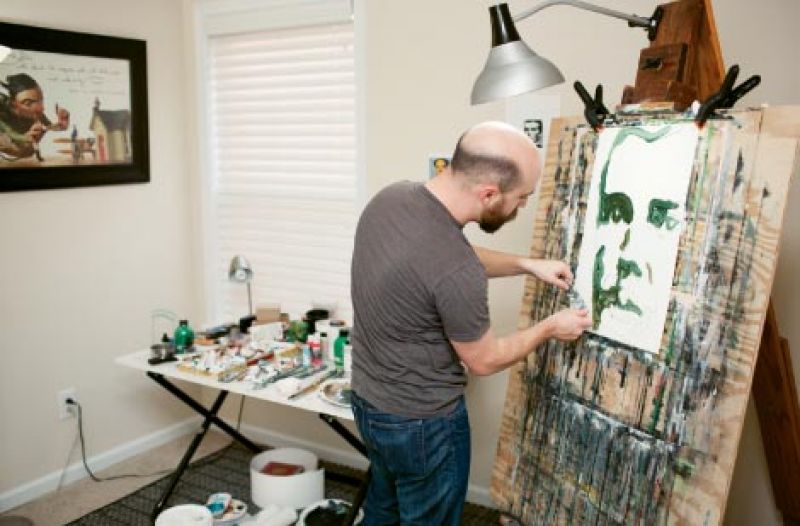
Greg Hart’s first-grade teacher told him he wasn’t drawing the “right way.” Living in Houston, Texas, at the time, he remembers the satisfaction he later felt when he began winning art competitions at rodeos and state fairs. “I was sure that teacher’s jaw was dropping,” he says. After his family returned to the South Carolina Upstate, Hart began taking art classes at the Fine Arts Center of Greenville County. “From elementary through high school, I learned about creative writing, ceramics, theater, metal design, painting, and drawing at the FAC.”
That early exposure laid the foundation for a career in the arts, and Hart continued to develop his expertise at University of South Carolina, studying film and media arts. After graduation, he attended the Atlanta College of Arts, studied illustration in Virginia, and began working as a freelance illustrator. “Freelance work was assignment-driven,” he says. “I was responding to what others were saying and not truly expressing myself.” In 2004, Hart moved to Charleston to be near his future wife, Janet, and continued to illustrate for publications such as The Washington Post and Utne Reader. But after five years of creating art for others, Hart says he wanted to find his own artistic voice. “So I ran,” he says, “I trained for a marathon. Running cleared my head and kicked the rust off.”
After a year or so of pounding the pavement and travels to Paris, Hart was ready to paint again and realized that he “might as well do exactly what I want.” He started with portraits and later began experimenting with daguerreotypes. “‘What’s past is prologue’—that’s the idea I’m playing with,” Hart explains. “I’m taking an antiquated, formal photographic process and translating that into a loose abstract painting with allusions to street art. That tension intrigues me.”
Today, Hart searches for subjects online, hunting down public domain photos taken during the late 1800s, because he prefers to paint anonymous people and inject his own story into his characters. But he also uses photographs of named individuals, his family, and himself. “Since childhood, my artwork has been focused on faces,” he explains. “While I can’t entirely explain the allure, I think it has to do with creating visual character studies and emphasizing the power of the individual.”
Zooming in on one face in a crowded family portrait, he uses Photoshop to push the levels and contrasts to create disappearing edges. Next, he makes a charcoal drawing of the image and then begins the underpainting stage. Last, Hart uses a variety of brushes, combs, and collage to create texture and the illusion of dimension. In Crow Creek, Chief Joseph Drifting Goose stares at the viewer, his eyes and mouth unsmiling. The planes of his face become sculptural with Hart’s broad, abstract brushstrokes.
Hart says he wants the viewer to know they are looking at a painting. “I don’t like refined, photo-realist art; I prefer painters who are aggressive and paint from the gut,” he says, citing the Fauves, abstract expressionist action painters, and street artists among his influences. Having found his voice in photos old and new, Hart is telling a unique story in his bold, vibrant portraits.